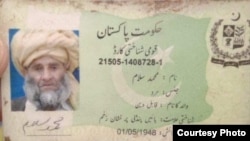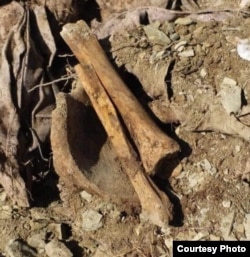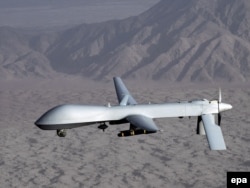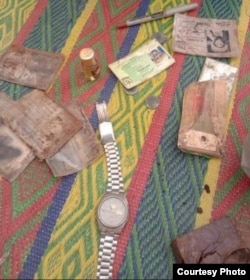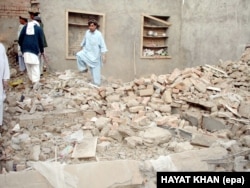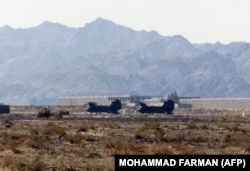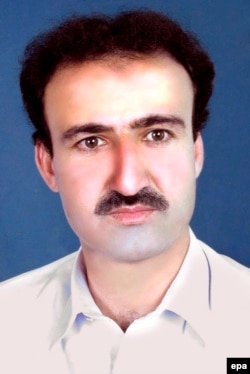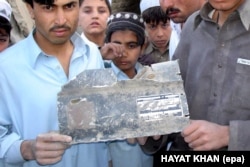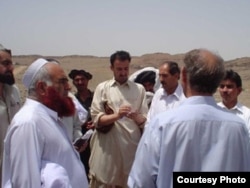When Pakistani road workers discovered human remains on their construction site in North Waziristan in early March, they unearthed more than the bones of an elderly teacher who was abducted and killed 13 years ago.
The victim, Muhammad Salam, was also a potential witness to the 2006 killing of Hayatullah Khan -- a journalist who had been reporting details of a military operation against Al-Qaeda militants sheltering in the area.
Some Pakistani sources tell RFE/RL they think the schoolteacher was abducted and killed because he knew too much about the journalist’s death.
They argue it is unlikely Salam’s killers were from the Taliban or Al-Qaeda because, at the time, those groups would publicly announce their kidnappings and killings -- often releasing videos of their victims and labeling them as spies or government agents.
Hayatullah Khan’s reporting and photographs from North Waziristan in December 2005 had shown that a senior Al-Qaeda leader had been killed in the lawless tribal region by a U.S. drone strike -- not in a bomb-making accident as Pakistan’s government had claimed.
Khan was abducted just two days after filing that story. He was killed six months later in front of the schoolteacher’s house in the village of Khaisor, about 15 kilometers from Khan's village of Hurmaz.
A government commission headed by Judge Muhammad Raza Khan of the Peshawar High Court investigated the killing of the journalist. That commission completed a 32-page report in late 2006 but its conclusions were never released to the public.
It remains unclear whether investigators had questioned Salam about the journalist’s death before the teacher was also abducted and killed by unknown assailants.
Safdar Dawar and Shamim Shahid, two Pakistani journalists who were friends of Khan, pieced together details about his death from accounts by local residents and relatives.
Shahid says villagers told him at Khan’s funeral that “the captors released Hayatullah near Salam’s house” on June 16, 2006, with his hands tied behind his back and told him to run.
“They said the captors opened fire at him as he was running and screaming for help,” shooting him in the back of the head, Dawar told RFE/RL.
Shahid says he was told that only women saw what happened because it was during Friday Prayers when all the men of the village were at the mosque.
“Several women went outside after they heard the shooting and one woman threw a stone at the killers’ car as it sped off,” Shahid told RFE/RL.
But one of Khan’s brothers, Ihsanullah Khan, told RFE/RL on March 15 that Salam had told him a slightly different account before the schoolteacher was also abducted and killed.
“Muhammad Salam told me my brother Hayatullah came to his house after escaping from his captors,” Ihsanullah said. “He told me that my brother was thin and very weak, and that he was asking for food and water. He told me he’d spent about 15 to 20 minutes with my brother there before his captors arrived and killed him.”
Another of Khan’s brothers, Haseenullah Khan, told PBS-TV’s Frontline program that the family believes Pakistan’s government was involved in the kidnapping and killing because of his investigative reporting on U.S. drone strikes in North Waziristan.
The Paris-based media rights group Reporters Without Borders has called for years, to no avail, for Pakistani authorities to release the results of the government’s investigation and explain Khan’s disappearance.
Human rights activists say the cases of both the slain journalist and schoolteacher fit a pattern seen in thousands of “enforced disappearances” since late 2001 allegedly carried out by Pakistan’s powerful military and intelligence services in the tribal regions near the Afghan border and in the restive province of Balochistan.
The Human Rights Commission of Pakistan noted in 2004 that "a relatively new form of violation of citizens’ most fundamental rights…was the phenomenon of disappearance, something that was not witnessed before or at least not to the extent now recorded.”
The Pakistani Senate’s Functional Committee on Human Rights also expressed concern in July 2006 about enforced disappearances.
But Pakistani authorities deny involvement in any of the disappearances.
In a 2006 report on Pakistan’s human rights record during the “war on terror,” Amnesty International concluded: “There can be no justification for Pakistan carrying out human rights violations, including arbitrary arrest, secret and unlawful detention, and enforced disappearances; torture and other ill-treatment; extrajudicial executions; and unlawful transfers to other countries.”
A Grisly Scene
The schoolteacher’s son, Shaukatullah Salam, rushed to the road construction site about 25 kilometers from the family’s home as soon as he received word in early March that the remains of a body had been dug up there.
Shaukatullah was 11 years old in December 2007 when he last saw his father leaving their house in Khaisor village near the town of Mir Ali.
The schoolteacher had told his son he was going to the bazaar to get some food and would return shortly. He never came home.
Now 24, Shaukatullah was horrified by the grisly scene at the roadwork near the village of Dosali where the remains were discovered.
Workers had uncovered the bones of an apparent torture victim whose hands were tied behind his back. Many of his bones had been broken.
Shaukatullah recognized a decaying waistcoat as what his father was wearing the last time he saw him. He also recognized his father’s watch and pen, items left in the shallow grave that suggest the killing was not the result of a robbery.
Erasing any doubt about the identity of the victim, Shaukatullah picked up his father’s plastic national identification card.
“We collected the bones in a box and we also collected his wristwatch, his pen, and his identification card,” Saukatullah said, adding that he was given the remains so the family could carry out a proper Islamic burial.
There was no forensic examination of the crime scene or Salam’s remains by Pakistani authorities.
"We had no enmity with anyone,” Shaukatullah told RFE/RL. “He was a mullah and an old man. And he was a schoolteacher with the Education Department.”
“For the past 13 years, whenever we would hear about a dead body being discovered on the road, we would rush to that place to see if that may be our father,” Shaukatullah said.
“From North Waziristan to Wana [the administrative center of neighboring South Waziristan], we have combed all of the areas and asked every tribal elder about our father’s whereabouts.”
“We met the political authorities with the help of his fellow teachers, but we were not given any clues,” Shaukatullah said.
Journalist’s Last Story
On December 5, 2005 -- about two years before the schoolteacher’s disappearance -- Pakistani journalist Hayatullah Khan was abducted by five unknown assailants while traveling to cover a protest against U.S. drone strikes in his home district of North Waziristan.
Just two days before his abduction, Khan had published what would be his last story in the Urdu-language daily newspaper Ausaf.
Five suspected Al-Qaeda militants had been killed by an explosion in the village of Asoray, which is north of North Waziristan’s administrative center, Miran Shah.
Among the dead was Abu Hamza Rabia, an Egyptian extremist described by U.S. intelligence officials as Al-Qaeda’s third-in-command under Osama bin Laden and Ayman al-Zawahri.
Rabia had filled a power vacuum within Al-Qaeda created in May 2005 when Pakistani intelligence agents captured the terrorist network’s previous operations chief, Abu Faraj al-Libbi.
According to then-Information Minister Sheikh Rashid Ahmed, who now heads Pakistan’s Interior Ministry, Rabia died while working to build a bomb in a house near Mir Ali where a large cache of munitions was stored.
But Khan’s interviews with witnesses and his photographs of shrapnel from a U.S.-made Hellfire missile indicated the Al-Qaeda operations chief in North Waziristan had been killed by an air strike from a U.S. Predator drone.
Khan’s photos were distributed internationally by the European Pressphoto Agency. That raised doubts from media around the world about Islamabad’s official version of how the Al-Qaeda leader had been killed.
U.S. officials initially refused to give details about Rabia’s death. But they later admitted to reporters in the United States that it was the result of a joint operation involving “U.S. and Pakistani resources.”
In fact, Rabia was killed by one of a series of U.S. drone strikes against Al-Qaeda figures carried out in North and South Waziristan during 2004 and 2005 as part of Operation Al-Mizan.
With Washington providing $2 billion a year to help Pakistan’s national security agencies fight Al-Qaeda militants sheltering in the tribal regions, Islamabad deployed up to 80,000 troops for Operation Al-Mizan from 2002 to 2006.
According to a RAND Corporation study in 2010 by Seth Jones and Christine Fair, those troops included regular army soldiers and the Frontier Corps, as well as officers from the Inter-Services Intelligence (ISI) and a battalion from Pakistan’s Special Services Group.
Then-Pakistani President Pervez Musharraf was also allowing the U.S. military to use Shamsi Airfield to the south of Quetta as a base for joint CIA operations, U.S. Air Force surveillance, and drone strikes against militants along the Afghan-Pakistan border.
Khan’s final story and photographs focused international attention on the secretive military operations at Shamsi Airfield -- suggesting they involved more than the refueling and maintenance of surveillance aircraft that the Pentagon was publicly admitting at the time.
That created an awkward domestic political situation for Musharraf’s government.
Initially, it had denied that U.S. drone strikes were taking place in Pakistan and attempted to hide evidence of such attacks.
Later, while publicly criticizing the United States for carrying out drone strikes in Pakistan, Islamabad continued to allow the attacks to be launched from that airfield in the southwestern part of the country.
It wasn’t until November 2011 -- after Washington cut its military aid disbursements to Pakistan and a NATO airstrike on the Afghan-Pakistan border killed 24 Pakistani soldiers -- that Islamabad ordered U.S. forces to vacate Shamsi Airfield.
Warned, Abducted, Killed
According to the U.S.-based nongovernment group Committee to Protect Journalists (CPJ), Khan had been summoned to meet with a Pakistani military intelligence officer in Miran Shah just a few weeks before his abduction.
CPJ says the intelligence official warned Khan to “leave his profession or leave Waziristan or accept the government’s political policies,” as U.S. drone strikes continued to be used as a tactic in Pakistan’s tribal regions as part of Operation Al-Mizan.
Khan’s brother, Ihsanullah, told CPJ that “Hayatullah passed his will to his tribe” on November 27, 2005, and “explicitly stated: ‘If I am kidnapped or get killed, the government agencies will be responsible.’”
After the journalist was abducted, his relatives received conflicting information from authorities about his whereabouts.
“Whatever role, if any, the government played in Khan’s killing, it appeared to engage in a cruel misinformation campaign during his six-month disappearance,” a CPJ investigative report into Khan’s case concluded in 2006.
“As Khan’s family careened between government sources in search of information, the official account morphed from one month to the next,” CPJ said. “Khan was in government custody, soon to be released; Khan had been abducted by ‘miscreants;’ he had been taken by Waziristan [mujahedin]; he had been flown to the military base at Rawalpindi and then detained in Kohat Air Base.”
After he had been missing for five months, CPJ says Khan’s relatives were told by a regional government agent that he’d been taken to the U.S.-run military base at Bagram Airfield in Afghanistan and the situation was “out of his hands.”
In an interview on June 8, 2006, President Musharraf denied that Hayatullah Khan was in the custody of Pakistani authorities.
But Shamim Shahid, the Peshawar bureau chief then for the English-language newspaper Nation, told RFE/RL he had received information from the Interior Ministry about Khan’s situation less than a week after Musharraf had denied his government was holding him and just two days before the journalist was killed.
“High-ranking officials informed me through a third person that Hayatullah was going to be released,” Shahid said. “But instead he was killed. That official contacted me because I was on the forefront of the case as an organizer of protests to demand that Hayatullah be freed.”
Shahid, who later testified before the government inquiry into Khan’s death, also told RFE/RL that Khan had visited him in Peshawar a week before his abduction -- indicating he was “under pressure” because of his earlier reporting about U.S. drone strikes in North Waziristan.
“He had booked a hotel room for the night, but I brought him out of the hotel and booked him a room at the Peshawar Press Club instead for security reasons,” Shahid said.
“He was my friend,” Shahid said. “After our talks on November 29, 2005, I told him not to go back to Waziristan. But he went back the next day without letting me know.”
Knowing Too Much?
Shaukatullah Salam, the son of the slain schoolteacher, told RFE/RL that he had no knowledge of his father’s involvement in any events related to the journalist’s abduction and death.
“The only connection our family has to this is that Hayatullah’s dead body was discovered close to our house,” Shaukatullah said.
But RFE/RL learned through a close relative of Khan that the schoolteacher did know members of the abducted journalist’s extended family.
That relative, who asked not to be named for safety reasons, said Khan’s family believes Salam knew the full story behind the kidnapping and killing of the journalist but was scared to talk about it publicly.
In November 2007, just a few weeks before Salam was abducted and killed, an unknown assassin slipped into the residential compound where Khan’s widow, Mehrunnisa, was living.
The assassin placed a remote-controlled bomb under the widow’s bedroom and killed her by detonating it during the night while she slept.
Mehrunnisa had claimed in an interview with the BBC after her husband’s death that he had fallen victim to a conspiracy hatched by the security forces in the tribal regions.
Ihsanullah Khan told RFE/RL that the family is now preparing to file a legal petition with the Supreme Court in Islamabad calling for the release of the 2006 report on the government’s inquiry into the journalist’s abduction and death.
Written and reported by Ron Synovitz in Prague with reporting by Daud Khattak




